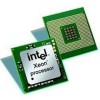Intel X5472 Specification Update - Page 19
Access Bit May be Set Prior to Signaling a Code Segment Limit
 |
UPC - 735858201551
View all Intel X5472 manuals
Add to My Manuals
Save this manual to your list of manuals |
Page 19 highlights
AX4. Non-Temporal Data Store May be Observed in Wrong Program Order Problem: When non-temporal data is accessed by multiple read operations in one thread while another thread performs a cacheable write operation to the same address, the data stored may be observed in wrong program order (i.e. later load operations may read older data). Implication: Software that uses non-temporal data without proper serialization before accessing the non-temporal data may observe data in wrong program order. Workaround: Software that conforms to the Intel® 64 and IA-32 Architectures Software Developer's Manual, Volume 3A, section "Buffering of Write Combining Memory Locations" will operate correctly. Status: For the steppings affected, see the Summary Tables of Changes. AX5. Page Access Bit May be Set Prior to Signaling a Code Segment Limit Fault Problem: If code segment limit is set close to the end of a code page, then due to this erratum the memory page Access bit (A bit) may be set for the subsequent page prior to general protection fault on code segment limit. Implication: When this erratum occurs, a non-accessed page which is present in memory and follows a page that contains the code segment limit may be tagged as accessed. Workaround: Erratum can be avoided by placing a guard page (non-present or non-executable page) as the last page of the segment or after the page that includes the code segment limit. Status: For the steppings affected, see the Summary Tables of Changes. AX6. Updating Code Page Directory Attributes without TLB Invalidation May Result in Improper Handling of Code #PF Problem: Code #PF (Page Fault exception) is normally handled in lower priority order relative to both code #DB (Debug Exception) and code Segment Limit Violation #GP (General Protection Fault). Due to this erratum, code #PF may be handled incorrectly, if all of the following conditions are met: 1. A PDE (Page Directory Entry) is modified without invalidating the corresponding TLB (Translation Look-aside Buffer) entry 2. Code execution transitions to a different code page such that both • The target linear address corresponds to the modified PDE • The PTE (Page Table Entry) for the target linear address has an A (Accessed) bit that is clear 3. One of the following simultaneous exception conditions is present following the code transition • Code #DB and code #PF • Code Segment Limit Violation #GP and code #PF Implication: Software may observe either incorrect processing of code #PF before code Segment Limit Violation #GP or processing of code #PF in lieu of code #DB. Workaround: None identified. Status: For the steppings affected, see the Summary Tables of Changes. AX7. Problem: Storage of PEBS Record Delayed Following Execution of MOV SS or STI When a performance monitoring counter is configured for PEBS (Precise Event Based Sampling), overflow of the counter results in storage of a PEBS record in the PEBS 19 Intel® Xeon® Processor 5400 Series Specification Update















